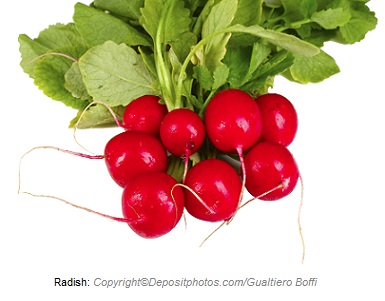Radish is a spicy and crunchy root vegetable from Brassica family and closely  related to broccoli and cauliflower. There are many varieties of radishes with different sizes, shapes, and colors (red, white and purple). One cup of sliced radish contains 4 grams of carbohydrates, 2 grams of fiber and 1 gram of protein.
related to broccoli and cauliflower. There are many varieties of radishes with different sizes, shapes, and colors (red, white and purple). One cup of sliced radish contains 4 grams of carbohydrates, 2 grams of fiber and 1 gram of protein.
Average calories: 20 per one cup, sliced.
|
Radish: one cup, sliced |
|
|
Carbohydrate |
4 |
|
Fiber |
2 |
|
Protein |
1 |
|
Fat |
0 |
|
Calories |
20 |
Vitamins found in higher amounts: vitamins C, B9, B5 and B2.
Minerals found in higher amounts: potassium, manganese, calcium, vanadium and magnesium. Vanadium is an essential trace mineral that helps with adjusting blood sugar level by making the cells more sensitive to insulin. Every 100 grams of radish provides 80 mcg of vanadium.
Phytonutrients found in higher amounts and their health benefits: the phytochemicals in radish are beta-carotene, caffeic acid, diallyl sulfide, ferulic acid, sulforaphane, methyl mercaptan, glucoraphanin, and raphanusin.
Beta-carotene is a carotenoid that has a key role in having healthy eye. It has an antioxidant activity as well.
Ferulic acid and caffeic acid are phenolic compounds. They are potent antioxidant with anti-inflammatory, anti-cancer and immune-boosting properties
Sulforaphane is a sulfur-contaning compoun that can inhibit the growth of Helicobacter Pylori, a microbe responsible for peptic ulcer and stomach upset. Sulforaphane is also found in Bok Choy, Brussels sprouts, cabbage, broccoli, kale, collards, kohlrabi, mustard, turnip, arugula, and watercress.
Glucoraphanin is another sulfur-containing substance in radish and can convert in the body into raphanin, which has antiviral, antifungal, and antibacterial activities.
Methyl mercaptan is an organic material, a colorless gas that is responsible for flatulence after having radish. It is also found in asparagus, nuts and certain cheeses.
The red color of radish results from an anthocyanin called raphanusin. It is a powerful antioxidant as well.

